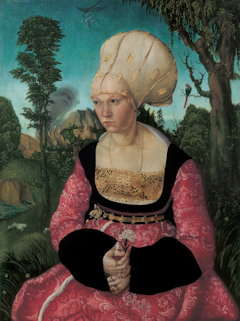
All great artists have their beginnings, offering insights into their development and style. The Cranach the Untamed exhibition at the Kunsthistorisches Museum (KHM) brings together rare early works by the great Renaissance painter, Lucas Cranach the Elder (ca. 1472-1553).
- Paintings include the fascinating Cuspinian portraits
- A collaboration with the Oskar Reinhardt Collection “Am Römerholz”
- Runs Jun 21 – Oct 16, 2022
- See also:
- Current art exhibitions in Vienna
Cranach the Untamed
(Lucas Cranach the Elder (Kronach 1472–1553 Weimar); Marriage Diptych of Johannes Cuspinian and Anna Cuspinian-Putsch, 1502; oil on panel (Picea sp.), each 60 x 45 cm © Sammlung Oskar Reinhart «Am Römerholz», Winterthur)
Lucas Cranach the Elder spent most of his working life (from 1504) at the court of Frederick III, Elector of Saxony, where he produced his many famous portraits.
(Frederick was one of those happy leaders who got a decent moniker: Frederick the Wise. A step up from his great grandfather, Henry the Mild, whose name probably failed to strike terror into the heart of his enemies.)
But what of the time before Saxony?
Where did Cranach go as a freshly-educated journeyman artist, out to collect experience of life and show his talent to the world (and possible sponsors)?
The central European states of the time failed to keep adequate digital personal and transport records, but experts remain fairly certain that one answer is Vienna, where Cranach probably arrived in or just after 1500.
This was the time of the great Emperor Maximilian I, one of the most charismatic, capable and cultured of Habsburg monarchs. And the University of Vienna already formed one of the humanist bastions of the era. Cranach likely enjoyed the patronage of various adherents of that philosophy.
The Cranach the Untamed exhibition (a collaboration between Vienna’s Kunsthistorisches Museum and Winterthur’s Oskar Reinhardt Collection “Am Römerholz”) draws together items from various collections to produce this first comprehensive overview of Cranach’s early art from his Viennese stay.
The works are few in number, but offer insights into the developing talent that would later leave such a legacy in European art.
Though we remain largely in ignorance of the artist’s time before and in Vienna, the art on display reveals an expressiveness unconstrained by the formal elegance required by Cranach’s later position at Frederick III’s court in Wittenberg.
For example, the double portrait (pictured above) of Johanes Cuspinian and Anna Cuspinian-Putsch lures us into the backgrounds, where all sorts of fun takes place: a castle on a hilltop, a washerwoman, an owl, a parrot (?), and an alarming plume of dark smoke.
And one of the Kunsthistorisches Museum’s own early Cranach paintings (The Crucifixion from ca. 1500) features far more blood and gore than, for example, his later The Flagellation of Christ from 1538.
This small exhibition guides us briefly through Vienna’s place in Cranach’s biography and artistic evolution. It presents both originals from the Vienna years, but also showcases documents and art based on lost works from that time.
So we can enjoy, for example, the Cuspinians, charcoal sketches, The Crucifixion or 1502’s The Penance of St. Jerome. But also, for example, the likes of Hieronymus Beck’s late 16th-century portrait codex (which includes some pictures likely based on Cranach’s Viennese originals).
Tickets, dates & tips
Enjoy a delve into Cranach’s past from June 21st to October 16th, 2022. An entrance ticket to the museum includes the exhibition.
Vienna has other opportunities to immerse yourself further in late medieval and early Renaissance art.
The Kunsthistorisches Museum’s picture galleries have works by Cranach the Elder in Saal IX and Kabinett 16, for example, along with contemporaries like Albrecht Dürer, Albrecht Altdorfer or Hans Holbein. Or pop over to the Italian section for Titian, Raffaello and similar.
You might also find paintings of a similar provenance at the Paintings Gallery of the Academy of Fine Arts Vienna.
Elsewhere, Belvedere has two permanent medieval exhibitions: one in the former Baroque stables, the other featuring masterpieces at Upper Belvedere. And consider visiting the remarkable altar panels at the Schottenstift Museum.
How to get to the KHM
See the main article on the Kunsthistorisches Museum for public transport tips (but the museum is very central, just opposite the Hofburg palace complex).
Address: Burgring 7, 1010 Vienna

